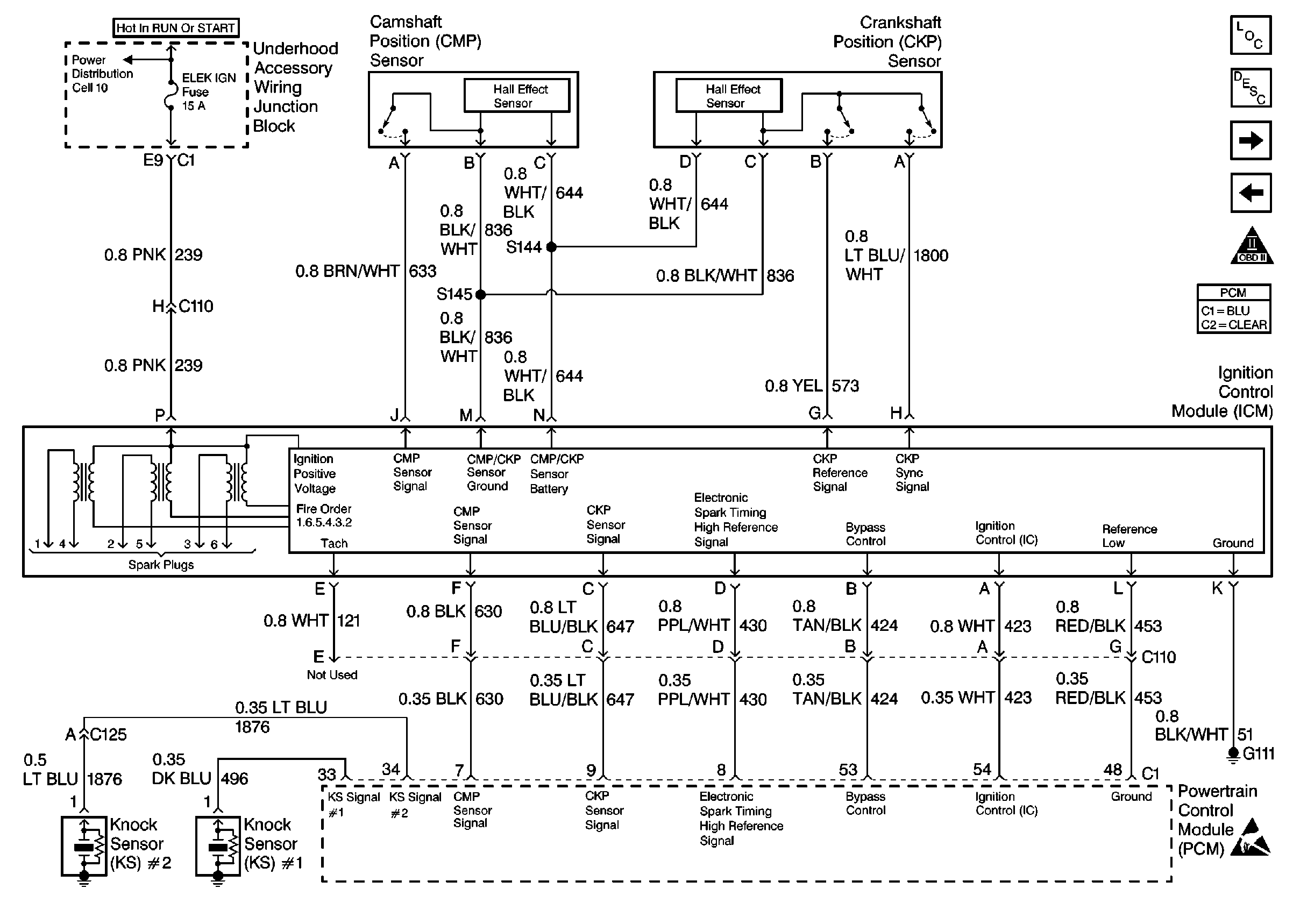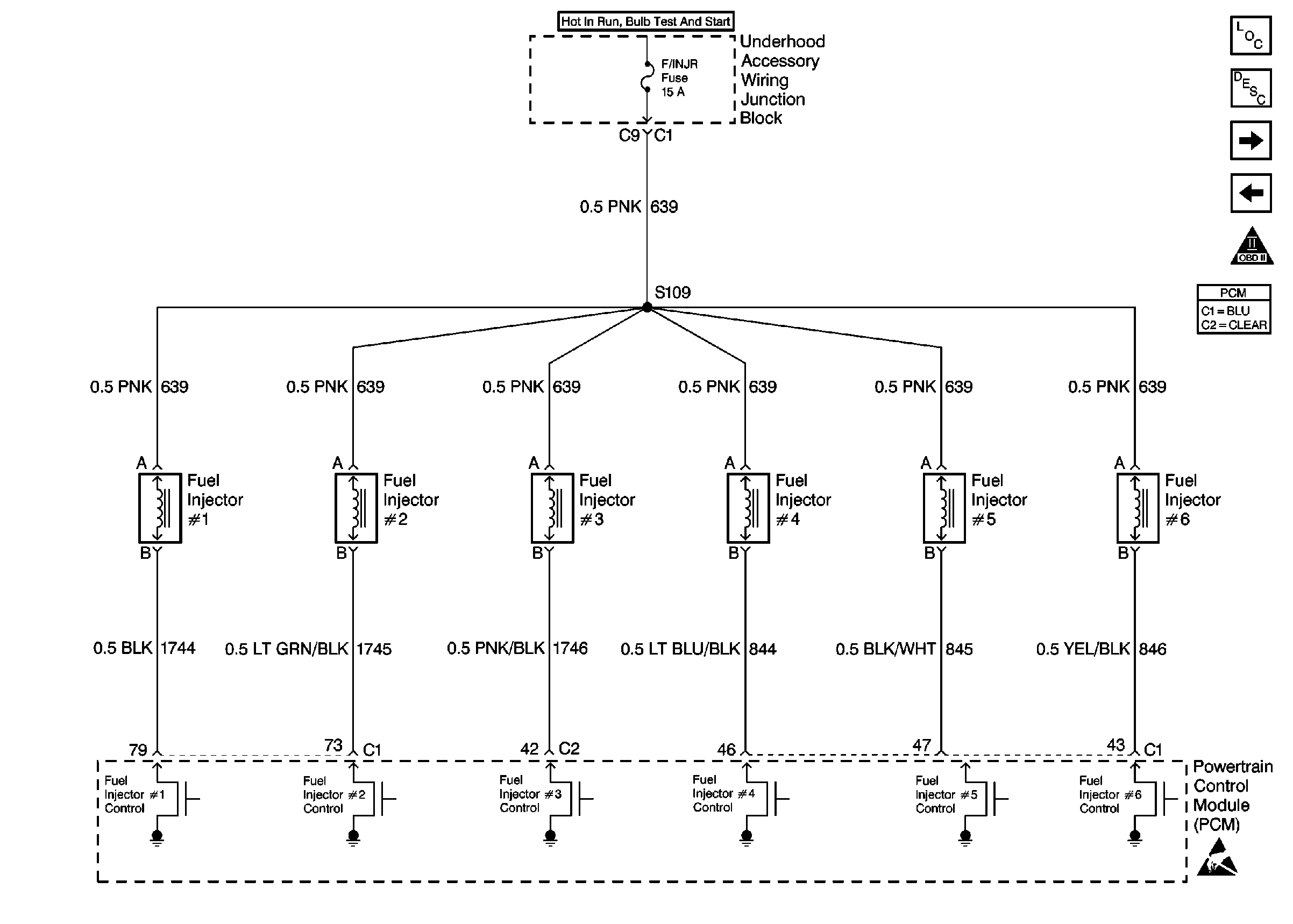Refer to
Ignition System, Knock Sensors

Refer to
Fuel Injectors

.
Circuit Description
The Electronic Ignition system uses a waste spark method of spark distribution. The ignition control module (ICM) determines the correct coil sequence based on the CKP sync signal received from the crankshaft position sensor. Two spark plugs connected to the coil fire at the same time. The cylinder on the compression stroke (event cylinder) uses most of the coil's available voltage to fire the spark plug. The cylinder on the exhaust stroke (waste cylinder) uses the remaining coil energy to fire the spark plug.
During crank, the ICM monitors the 18X CKP and CKP sync signals. The ICM uses CKP sync signal to determine the correct cylinder pair to fire first. Only the ICM uses the CKP sync signal. The ICM does not pass the CKP signal to the PCM. While the ICM processes the CKP sync signal, the ICM also monitors the 18X CKP signal. The ICM uses the 18X signal for crankshaft position information and to generate 3X reference pulses. The ICM sends the 18X and 3X reference pulses to the PCM. When the PCM receives these pulses, the PCM energizes all six injectors to allow a priming shot of fuel for the cylinders. After priming the cylinders, the PCM shuts the injectors OFF for the next six, 3X reference pulses. This allows each cylinder a chance to use the fuel from the priming shot. During this waiting period, the PCM receives a camshaft position (CMP) signal pulse. The CMP signal allows the PCM to calculate true sequential fuel injection. If a loss of the CMP signal occur during start-up, the PCM still operates the fuel injectors sequentially. However, fuel injection occurs with a 1 in 6 chance that the injector sequencing is correct.
Diagnostic Aids
An intermittent may be caused by a poor connection, rubbed through wire insulation or a wire broken inside the insulation. Check for the following items:
| • | Poor connection or damaged harness. Inspect the PCM harness and connectors for improper mating, broken locks, improperly formed or damaged terminals, poor terminal to wire connection, and damaged harness. |
| • | Faulty Engine Coolant Temperature Sensor. Using a scan tool, compare Engine Coolant Temperature with Intake Air Temperature on a completely cool engine. Engine Coolant Temperature should be within 10° C of Intake Air Temperature. If not, replace the ECT sensor. Refer to Engine Coolant Temperature Sensor Replacement . |
Test Description
Number(s) below refer to the step number(s) on the Diagnostic Table:
-
Determines if the ignition control module (ICM) is receiving the 18X CKP Reference signal. If the 18X CKP signal to the ICM is not present, there will be no RPM, spark, or fuel injector pulses.
-
Ensures that the ICM has the proper voltage supply and ground.
-
Verifies that the ICM is supplying the proper sensor feed voltage.
-
Check for the proper operation of the CKP Sync signal, ICM and related spark system components. Without the CKP Sync signal the ICM is unable to properly sequence the ignition coils.
-
If the 18X and CKP Sync signals to the ICM or the 18X and 3X reference signals to the ICM short together the vehicle will not start and run. However, there will be spark and fuel injector pulses.
-
This vehicle is equipped with a PCM which utilizes an Electrically Erasable Programmable Read Only Memory (EEPROM). When the PCM is being replaced, the new PCM must be programmed.
Step | Action | Value(s) | Yes | No | ||||||||||||||||
|---|---|---|---|---|---|---|---|---|---|---|---|---|---|---|---|---|---|---|---|---|
1 | Was the Powertrain On-Board Diagnostic (OBD) System Check performed? | -- | ||||||||||||||||||
2 |
Important: Before proceeding with this diagnostic Table, ensure that the vehicle battery is fully charged. Important: If any DTCs are stored as failed since code clear, diagnose the DTCs before continuing with this table.
Did you find and correct the condition? | -- | ||||||||||||||||||
3 |
Is the fuel pressure within the specified values and holding? | 333-376 kPa (48-55 psi) | ||||||||||||||||||
4 | Is any fuel pressure indicated? | -- | ||||||||||||||||||
Does the scan tool indicate an engine RPM? | -- | |||||||||||||||||||
Does the test lamp illuminate? | -- | |||||||||||||||||||
7 |
Does the test lamp illuminate? | -- | ||||||||||||||||||
Is the voltage near the specified value? | B+ | |||||||||||||||||||
9 | Measure the voltage between the sensor signal and sensor ground circuits in the 18X sensor connector using a DMM. Is the voltage within the specified values? | 6V-9V | ||||||||||||||||||
10 | Check for poor connections at the 18X sensor. If a problem is found, repair as necessary. Refer to Intermittents and Poor Connections Diagnosis . Did you find and correct the condition? | -- | ||||||||||||||||||
11 | Measure the voltage on the sensor feed circuit at the 18X sensor connector using a DMM that is connected to a good ground. Is the voltage near the specified value? | B+ | ||||||||||||||||||
12 |
If a problem is found, repair as necessary. Refer to Wiring Repairs . Did you find and correct the condition? | -- | ||||||||||||||||||
13 |
If a problem is found, repair as necessary. Refer to Wiring Repairs . Did you find and correct the condition? | -- | ||||||||||||||||||
14 |
Is any voltage present? | -- | ||||||||||||||||||
15 | Locate and repair the short to voltage on the 18X sensor signal circuit. Refer to Wiring Repairs . Did you find and correct the condition? | -- | -- | |||||||||||||||||
16 |
If a problem is found, repair as necessary. Refer to Wiring Repairs . Did you find and correct the condition? | -- | ||||||||||||||||||
17 |
Did the injector test lamp illuminate for any of the injectors? | -- | ||||||||||||||||||
18 |
Was the test lamp illuminated for any of the injectors? | -- | ||||||||||||||||||
19 |
Did the injector test lamp blink for each injector? | -- | ||||||||||||||||||
20 | Did the injector test lamp blink for any of the injectors? | -- | ||||||||||||||||||
21 |
If a problem is found, repair as necessary. Refer to Wiring Repairs . Did you find and correct the condition? | -- | ||||||||||||||||||
22 |
Does the test lamp illuminate? | -- | ||||||||||||||||||
23 | Locate and repair the open ignition positive feed circuit to the fuel injectors. Refer to Wiring Repairs . Is action complete? | -- | -- | |||||||||||||||||
Is spark available at all cylinders? | -- | |||||||||||||||||||
25 | Is spark available at any cylinder? | -- | ||||||||||||||||||
26 |
Is the voltage near the specified value? | 6V-9V | ||||||||||||||||||
27 | Check for poor connections at the 18X sensor. If a problem is found, repair as necessary. Refer to Intermittents and Poor Connections Diagnosis . Did you find and correct the condition? | -- | ||||||||||||||||||
28 |
If a problem is found, repair as necessary. Refer to Wiring Repairs . Did you find and correct the condition? | -- | ||||||||||||||||||
29 |
If a problem is found, repair as necessary. Refer to Wiring Repairs . Did you find and correct the condition? | -- | ||||||||||||||||||
30 |
If a problem is found, replace the damaged ignition component(s). Refer to Ignition Coil Replacement . Did you find and correct the condition? | -- | ||||||||||||||||||
31 | Measure the ignition coil secondary resistance using a DMM. If any resistance is outside the specified values, replace the malfunctioning ignition coil(s) as necessary. Refer to Ignition Coil Replacement . Did you find and correct the condition? | 5K-8K ohms (5000 - 8000 ohms) | ||||||||||||||||||
32 | Measure the resistance of the ignition wires associated with the cylinders that did not have spark using a DMM. Replace the ignition wire(s) that measure greater than the specified value. Refer to Ignition Coil Replacement . Did you find and correct the condition? | 600 ohms/ft | ||||||||||||||||||
33 |
Does the test lamp blink continuously while the engine is being cranked? | -- | ||||||||||||||||||
34 |
Did the spark plug inspection reveal excessive fouling? | -- | Go to Base Engine Misfire Diagnosis in Engine Mechanical | |||||||||||||||||
Refer to Diagnostic Aids to check for the following condition(s):
If a problem is found, repair as necessary. Refer to Wiring Repairs . Did you find and correct the condition? | -- | |||||||||||||||||||
36 | Test the fuel for contamination. Refer to Alcohol/Contaminants-in-Fuel Diagnosis . If a problem is found, clean the fuel system and correct the contaminated fuel conditions as necessary. Did you find and correct the condition? | -- | ||||||||||||||||||
37 | Repair the engine mechanical problem. Refer to Base Engine Misfire Diagnosis in Engine Mechanical to diagnose the following condition(s):
Is the action complete? | -- | -- | |||||||||||||||||
38 | Check for poor connections at the ICM. If a problem is found, repair as necessary. Refer to Intermittents and Poor Connections Diagnosis . Did you find and correct the condition? | -- | ||||||||||||||||||
39 | Locate and repair the open in the ICM ground circuit. Refer to Wiring Repairs . Is the action complete? | -- | -- | |||||||||||||||||
40 | Locate and repair the open in the ignition positive feed circuit to the ICM. Refer to Wiring Repairs . Is the action complete? | -- | -- | |||||||||||||||||
41 | Replace the 18X CKP sensor. Refer to Crankshaft Position Sensor Replacement . Is the action complete? | -- | -- | |||||||||||||||||
42 | Replace the ICM. Refer to Ignition Control Module Replacement . Is the action complete? | -- | -- | |||||||||||||||||
43 | Locate and repair the short to ground in the fuel injector control circuit(s) associated with the injector test lamp(s) that stayed illuminated. Refer to Wiring Repairs . Is the action complete? | -- | -- | |||||||||||||||||
44 | Check for poor connections at the PCM. If a problem is found, repair as necessary. Refer to Intermittents and Poor Connections Diagnosis . Did you find and correct the condition? | -- | ||||||||||||||||||
45 | Replace the ignition coil(s) associated with the cylinder(s) that did not have spark. Refer to Ignition Coil Replacement . Is the action complete? | -- | -- | |||||||||||||||||
|
Important: Replacement PCM must be reprogrammed. Refer to Powertrain Control Module Replacement/Programming . Replace the PCM. Is action complete? | -- | -- |
